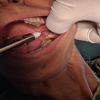1. Milgrom P, Newton JT, Boyle C, Heaton LJ, Donaldson N. The Effects Of Dental Anxiety And Irregular Attendance On Referral For Dental Treatment Under Sedation Within The National Health Service In London. Community Dent Oral Epidemiol. 2010; 38:453–459.

2. Kaufman E, Epstein JB, Naveh E, Gorsky M, Gross A, Cohen G. A Survey of Pain, Pressure, and Discomfort Induced by Commonly Used Oral Local Anesthesia Injections. Anesth Prog. 2005; 52:122–127.

3. Milgrom P, Coldwell SE, Getz T, Weinstein P, Ramsay DS. Four dimensions of fear of dental injections. J Am Dent Assoc. 1997; 128:756–766.

4. Hochman MN, Friedman MJ, Williams W, Hochman CB. Interstitial tissue pressure associated with dental injections: A clinical study. Quintessence Int. 2006; 37:469–476.
5. Walmsley AD, Lloyd JM, Harrington E. Pressures produced in vitro during intraligamentary anaesthesia. Br Dent J. 1989; 167:341–344.

6. Kwak EJ, Pang NS, Cho JH, Jung BY, Kim KD, Park W. Computer-controlled local anesthetic delivery for painless anesthesia: a literature review. J Dent Anesth Pain Med. 2016; 16:81–88.

7. Lesaffre E, Philstrom B, Needleman I, Worthington H. The design and analysis of split-mouth studies: What statisticians and clinicians should know. Stat Med. 2009; 28:3470–3482.

8. Hochman MN, Friedman MJ. In vitro study of needle deflection: A linear insertion technique versus a bidirectional rotation insertion technique. Quintessence Int. 2000; 31:33–39.
9. Tandon N, Kalra S, Balhara YPS, Baruah MP, Chadha M, Chandalia HB, et al. Forum for Injection Technique and Therapy Expert Recommendations, India: The Indian Recommendations for Best Practice in Insulin Injection Technique, 2017. Indian J Endocrinol Metab. 2017; 21:600–617.

10. Seligman LD, Hovey JD, Chacon K, Ollendick TH. Dental anxiety: An understudied problem in youth. Clin Psychol Rev. 2017; 55:25–40.

11. Moore R, Brødsgaard I, Rosenberg N. The contribution of embarrassment to phobic dental anxiety: a qualitative research study. BMC Psychiatry. 2004; 4:10.

12. Takahashi H, Ban M, Asada M. Semantic differential scale method can reveal multi-dimensional aspects of mind perception. Front Psychol. 2016; 7:1717.

13. Yenisey M. Comparison of the pain levels of computer controlled and conventional anesthesia techniques in prosthodontic treatment. J Appl Oral Sci. 2009; 17:414–420.

14. Doig GS, Simpson F. Randomization and allocation concealment: a practical guide for researchers. J Crit Care. 2005; 20:187–193.

15. Klimek L, Bergmann KC, Biedermann T, Bousquet J, Hellings P, Jung K, et al. Visual analogue scales (VAS): Measuring instruments for the documentation of symptoms and therapy monitoring in cases of allergic rhinitis in everyday health care. Allergo J Int. 2017; 26:16–24.

16. Feda M, Al Amoudi N, Sharaf A, Hanno A, Farsi N, Masoud I, et al. A Comparative Study of Children's Pain Reactions and Perceptions to AMSA Injection using CCLAD versus Traditional Injections. J Clin Pediatr Dent. 2010; 34:217–222.

17. Yogesh Kumar TD, John JB, Asokan S, Geetha Priya PR, Punithavathy R, Praburajan V. Behavioral response and pain perception to computer controlled local anesthetic delivery system and cartridge syringe. J Indian Soc Pedod Prev Dent. 2015; 33:223–228.

18. Baghlaf K, Alamoudi N, Elashiry E, Farsi N, El Derwi DA, Abdullah AM. The pain-related behavior and pain perception associated with computerized anesthesia in pulpotomies of mandibular primary molars: A randomized controlled trial. Quintessence Int. 2015; 46:799–806.
19. Chang H, Noh J, Lee J, Kim S, Koo KT, Kim TI, et al. Relief of Injection Pain During the Delivery of Local Anesthesia by Computer-Controlled Anesthetic Delivery System for Periodontal Surgery: Randomised Clinical Controlled Trial. J Periodontol. 2016; 87:783–789.

20. Sumer M, Mısır F, Koyuturk AE. Comparison of the Wand with a conventional technique. Oral Surg Oral Med Oral Pathol Oral Radiol Endod. 2006; 101:e106–e109.






 PDF
PDF ePub
ePub Citation
Citation Print
Print









 XML Download
XML Download